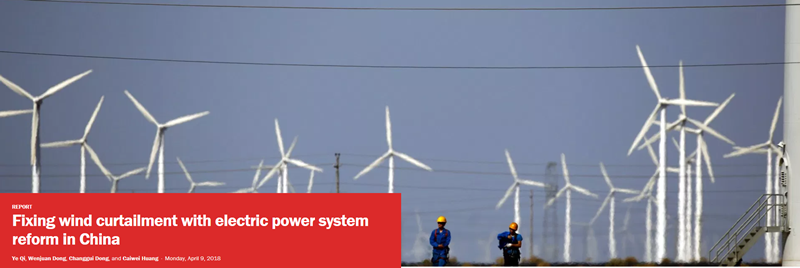
Fixing wind curtailment with electric power system reform in China
Ye Qi, Wenjuan Dong, Changgui Dong, and Caiwei HuangMonday, April 9, 2018
Editor's Note: The Brookings-Tsinghua Center has launched a research project, China’s Energy in Transition, to provide an assessment of how to transform China’s energy system to a climate- and environmentally-friendly one, and to assist policymakers and the general public in understanding the complexities of the topic and challenges ahead. The following report is one of the major pieces in this series.
Wind curtailment is the reduction in electricity generation below what a system of well-functioning wind turbines are capable of producing. It represents a significant loss in economic and energy efficiency. In 2016, the wind electricity curtailment in China amounted to 49.7 TWh, enough to cover the total annual electricity consumption of Bangladesh, with a population of 163 million. If the abandoned wind electricity were fully utilized as a substitute for coal, China could have reduced its CO2 emissions by 42 million tons, close to the total emissions of Bulgaria. The severity of China’s wind curtailment problem reflects underlying problems in the country’s electricity regulatory regime. In the context of ongoing reforms in the power sector, addressing the issue of wind curtailment could also support the transition towards renewable-friendly institutional arrangements.
The recurrence of China’s wind curtailment problem underscores the vulnerability of China’s electricity regulatory regime. While China’s wind power development has been plagued by wind curtailment from the early days, the problem was alleviated in 2013 and 2014 following government pressure for better grid connections. However, with economic deceleration and the resultant low growth in electricity demand, the wind curtailment rate bounced back in 2015. The wind curtailment rate—the ratio of curtailed electricity to total wind generation—typically exceeds 20% in wind-rich provinces in China, ten times that of most other countries. In some countries, severe wind curtailment only occurs temporarily but can be mitigated after a few years through the expansion of transmission networks and market design and optimization. In contrast, wind curtailment in China has persisted and even worsened in recent years, which suggests institutional causes.
Lieberthal and Oksenberg coined the term “fragmented authoritarianism” to explain the political economy of China’s electric power system. The electric power sector is a typical natural monopoly, with a rigid hierarchy, and is dominated by state-owned enterprises (SOEs). Investment, electricity production, and allocation in the power sector are still largely controlled by the government, mostly at the provincial level. Although China initiated two rounds of power-sector marketization reform in 2002 and 2015, the role of price signals remains limited and state control over the electricity system remains strong. The electricity regulatory regime has been and will remain guided by a dual-track approach, with both central planning and market forces at play, but with an increasingly important role for the latter.
In this report, we focus on electric power regulatory framework to explain the wind curtailment problem in China, and probe into its root causes. Our analysis utilizes the concept of “fragmented authoritarianism,” and highlights the lack of coordination in this sector. We use two case studies to illustrate the institutional causes of wind curtailment in different regions. Under the current top-down system, fragmented electric power regulation is identified as the fundamental cause of China’s wind curtailment problem.
Fragmentation in electric power regulation exists at both the vertical and the horizontal levels. At the vertical level, regulatory authority is assigned to the central government and the provincial governments. While the central government sets national policies, individual provincial governments determine power generation and allocation within their respective jurisdictions. At the horizontal level, regulation responsibilities are scattered among different ministries or departments of the central and local governments. Decision-making authority is even more fragmented within each ministry or department. Moreover, state-owned grid companies and generation companies have strong bargaining power under this system. The scattered allocation of power and responsibilities in both the central and provincial governments lead to departmentalism and difficulty in coordination.


































